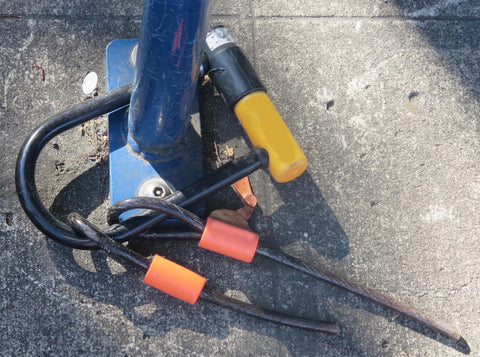Lock Smart: Here's How
Location, Location, Location: Lock your bike somewhere well lit and with moderate to high foot traffic. The potential for passersby to notice suspicious activity makes it riskier for a would-be thief to take a bolt cutter or an angle grinder to your lock, your bike, or the rack.

Infrastructure: Lock your bike to something immobile and sturdy. Check that any bolts are present and tight and that everything’s structurally sound. Make sure that the bike/lock combo can’t be lifted up, off, and away.

Lock: Choose a lock that can’t be cut quickly. Never rely on a cable lock alone, as these can be—and are—cut quickly and quietly. Selecting a bike lock is a personal choice that involves balancing such competing priorities as cost, weight, and security. Choose a lock that fits your needs—Altor’s SAF lock for your two-wheeled commute, perhaps, or an Altor APEX for errands or touring—and don’t scrimp. Kensington and Chelsea’s award-winning Bikeminded campaign recommends a lock worth 20 percent of the value of your ride. That’s a $200 lock for a $1000 bike!

Technique: Lock both your bike frame and at least one wheel. It is often possible to get a lock around a rack, rear wheel, and seat tube. The rear wheel is more expensive to replace than the front wheel, so if you’re only going to secure one, secure the rear. A cable or secondary lock (or a locking skewer) can be used to deter theft of the front wheel. Two—or more!—of Altor’s APEX Series locks can be locked end-to-end for lock-ups that require more reach.
Pro Tip #1: Keep your lock well above ground. When a lock is in contact with the ground, it is more vulnerable to attack by a hammer.
Pro Tip #2: Do Not Leave Room For Tools. Make sure to leave as little room as possible between your bike, lock and what you are locked to. The less room thieves have to manipulate tools in and around your bike lock, the harder it will be for them to break it.
Pro Tip #3: Deter twist attacks. Thieves have been known to repurpose scaffolding poles and the like as instruments of theft. Threading a pole through a lock and twisting until breakage is only appealing, though, if the first thing the lock touches when twisted is the rack rather than the bike frame. Take this into consideration when positioning your lock.
No lock is a 100% guarantee against bike theft. But get a good lock—and deploy it properly—and you can greatly increase your chances of holding on to your ride long-term. Lock smart, cyclists.



